
The crop division of the Alebor Group grain trading company has completed the 2025 production season, the company’s press service reported on Facebook.
According to the report, the company’s specialists grew and harvested wheat from 2,000 hectares with a yield of over 7 tons/hectare, corn from 1,100 hectares with a yield of 14.5 tons/hectare, rapeseed from 1,500 hectares with a yield of 3.6 tons per hectare, and sunflower from 1,800 hectares with a yield of 3.85 tons per hectare.
Alebor Group is a trading company founded in 2006 in the Cherkasy region. Its structure includes the Khristinivskoye Grain Receiving Enterprise (with a storage capacity of 74,000 tons of grain), the Voronovitske Grain Receiving Enterprise (104,000 tons of grain), Chesne Grain Receiving Enterprise (27,500 tons of grain), transport companies Boleko and Avtoera with a fleet of 210 heavy-duty grain trucks, and construction company Alebor Real Estate.
According to information on the company’s website, Alebor Group is one of the top 20 grain trading companies in Ukraine, exporting about 2 million tons of grain annually. The group has its own land bank of 6,500 hectares. The company’s founder is Oleksiy Kustov.
KMZ Industries is the largest manufacturer of elevator equipment in Ukraine and produces a full range of products, including silos, grain dryers, transport equipment, and separators, as well as providing automation and installation services.
According to the company, it has built more than 5,000 facilities. KMZ Industries silos with a total volume of more than 12.5 million cubic meters are in operation.
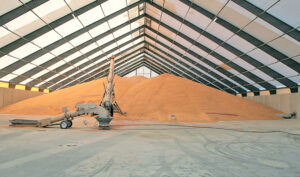
The Food and Agriculture Organization of the United Nations (FAO) has completed the distribution of 615 modular grain storage facilities to small and medium-sized farms in seven frontline areas, the FAO press service reported on Facebook.
The FAO specified that this initiative was implemented with the support of the governments of Canada and Japan in close cooperation with the Ministry of Economy, Environment, and Agriculture. The FAO is convinced that the program contributes to stabilizing the work of farms, preventing post-harvest losses, and ensuring the continuity of agricultural production.
Farmers could apply to participate in the program through the State Agrarian Register (DAR). In 2025, the FAO received 747 applications from producers who cultivate between 200 and 1,000 hectares. After verification, 615 farms were selected to receive modular grain storage facilities. The distribution took place in seven regions: Chernihiv (62), Dnipropetrovsk (116), Kharkiv (124), Kherson (14), Kirovohrad (84), Mykolaiv (128), and Odesa (87).
This initiative is part of a broader Grain Storage Support Strategy that FAO and partners have been implementing since 2022 in response to a critical shortage of storage capacity. During this time, Ukrainian agricultural producers have received a wide range of storage solutions – more than 37,000 grain sleeves, 105 sets of loading and unloading equipment, and a total of 859 modular grain storage facilities. Collectively, this support has enabled farmers across Ukraine to preserve more than 8 million tons of grain and sustain agricultural production in wartime conditions.
Despite significant progress, the lack of storage infrastructure remains a key constraint to the recovery of the agricultural sector, especially in frontline and recently liberated areas, the FAO stressed. As preparations for the 2026 season get underway, the sustainable development of modern and secure grain storage facilities will remain critical to protecting livelihoods and preserving national food production.
“For farmers, the ability to safely store their harvest is not just about grain. It’s about peace of mind, about the confidence that months of hard work will not be lost. These storage facilities give Ukrainian farmers what is especially needed today in times of war: stability and the ability to look to the future with hope. We will continue to support them on this path,” assured Shakhnoza Muminova, Head of the FAO Office in Ukraine.
FAO, together with its partners, plans to provide support to approximately 100 more farmers in early 2026, but the scale of needs far exceeds available resources. Strengthened cooperation and continued active involvement of the international community will be key to enabling farmers to withstand ongoing challenges and contribute to Ukraine’s long-term recovery, the organization believes.
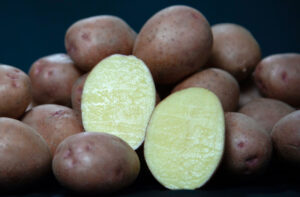
In Ukraine, the area under potatoes in the 2025 season increased by 25% compared to last year, and thanks to favorable weather conditions, the yield was also a quarter higher, so it can be assumed that the harvest of Ukrainians’ second bread is 50% higher than last year, said Mykola Furdyga, director of the Potato Institute.
“It is very easy to calculate how much potatoes we produce. If the average farm price is 8 UAH/kg, and last year it was 20 UAH/kg, then I think we have 50% more production: production areas have expanded by 25% and the harvest has increased by 25% thanks to weather conditions,“ he said at the conference ”The state of development of the potato industry and the potential of processing enterprises in Volyn.”
Furdyga noted that Ukraine does not need such a volume of grown potatoes even in the case of deep processing (into chips and starch – IF-U).
Commenting on Ukraine’s import of more than 123,000 tons of potatoes in the 2024-2025 marketing year, the scientist explained that this record volume of sales abroad was caused by the unusual weather conditions of 2024 (Ukraine experienced a “record” drought – IF-U). Therefore, the state was forced to import potatoes to meet domestic food needs. European countries willingly supplied Ukraine with products due to their attractive price. At the same time, potatoes from Egypt did not dominate the market, but occupied their traditional niche in the off-season (February-March – IF-U), he noted.
In addition, Ukraine traditionally imports seed potatoes from leading breeding companies in the European Union, the director of the Potato Institute recalled.
Furdyga stated that since the beginning of the war, there has been a trend in Ukraine toward a reduction in potato cultivation in households and an expansion of production areas for this crop in farms and even in agricultural holdings. He explained this trend by the departure of the population from villages abroad and mobilization.
“For example, in Vinnytsia and Zhytomyr regions, there are villages where households used to plant 30 hectares of potatoes, and now if they plant 2 hectares, that’s still good,” he said, adding that potato cultivation is becoming unprofitable and labor-intensive for households.
Furdyga estimated the share of domestic potato varieties in national production at around 10-12%, given that they are mainly grown by small producers and households.
“Of course, we would like to have a larger market share, but this is the situation at the moment. I can only boast that in the 2025 season, domestic varieties were grown by the farms of Biotech Ltd. and Brovary Kartoplya Ltd. in the Kyiv region and STOV Desna in the Chernihiv region. In total, they propagated domestic varieties for further sale on an area of about 300 hectares,” said the director of the Potato Institute.
As reported, in 2024, due to unfavorable weather conditions and, in particular, drought, Ukraine’s potato harvest was 18% lower, i.e., by 4 million tons, to approximately 17.36 million tons, compared to 21.36 million tons in 2023.
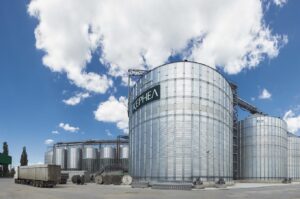
Kernel, one of Ukraine’s largest agricultural holdings, exported 1.3 million tons of grain in July-September 2026 (FY, July 2025-June 2026) exported 1.3 million tons of grain, which is 15% less than in the same period last year, but 27% more than in the previous quarter, thanks to greater availability of grain on the domestic market after the start of the winter wheat harvest.
According to the published quarterly report, wheat accounted for 74% of Kernel’s total exports, with the rest being corn and barley.
“The start of the new financial year for the Infrastructure and Trade segment was shaped by two key market dynamics: a delay in the harvesting campaign in Ukraine caused by weather conditions and slower-than-usual sales by farmers,” the agricultural holding said.
As a result, the cargo turnover of export terminals in the first quarter of FY 2026 amounted to 1.8 million tons, which is 17% less than in the same period last year, leading to a decrease in grain exports and the group’s overall sales portfolio of vegetable oils and meal.
Grain accounted for 75% of the total cargo turnover, edible oils for 13%, and vegetable meal for the rest.
The volume of grain received by silos in July-September 2026 FR amounted to 1.2 million tons, which is 34% less than in the previous year. Of this amount, 796 thousand tons were received from the agricultural holding’s own agricultural enterprises, and the rest from third-party suppliers.
“The decrease in arrivals mainly reflects the later start of the group’s harvesting campaign, as unfavorable weather conditions and uneven ripeness of crops in different regions delayed and reduced deliveries to warehouses,” Kernel explained.
The Infrastructure and Trade segment generated EBITDA of $20 million in the first quarter of 2026 FY, down 62% from the previous year.
Before the war, Kernel was the world’s leading producer of sunflower oil (about 7% of global production) and its exporter (about 12%). It is one of the largest producers and sellers of bottled oil in Ukraine. In addition, it is engaged in the cultivation and sale of agricultural products.
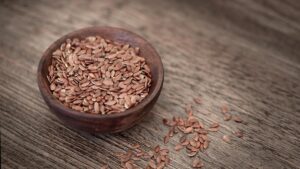
In Ukraine, oil flax remains a niche crop, but its gross harvest in the 2025-2026 marketing year (MY) will amount to 66 thousand tons, which is the highest result since the 2017/18 MY, according to the information and analytical publication UkrAgroConsult.
“Production is subject to fluctuations influenced by market factors and weather conditions. Since 2020, there has been a steady expansion of acreage. Growth is driven by demand from the EU, the main importer of flax. (…) The combination of expanded acreage and improved yields has been decisive. In the 2024/25 MY, there has been a partial recovery in yields, which are still below the crop’s potential,” analysts explained.
Experts noted that exports remain a key driver of the market — more than 80% of the Ukrainian flax harvest in 2024/25 MY is sent abroad. During the years of war, this share has more than doubled.
The main destination for flax sales is the EU (Italy, Poland, and Belgium are the top importers). After the start of the full-scale war, EU countries significantly reduced their purchases of Russian flax, reorienting themselves to alternative suppliers from Ukraine, Kazakhstan, and Canada.
At the same time, after peaking in 2023/24 MY (over 70 thousand tons), shipments from Ukraine decreased by approximately 24% in 2024/25 MY.
“The Ukrainian oil flax market is entering a phase of stable recovery. The crop is gradually regaining its position in the crop structure, forming a new niche for small and medium-sized agricultural producers. With support for exports and the development of processing, flax has the potential to establish itself as a promising alternative crop for the northern regions of the country, which are increasingly facing weather risks,” UkrAgroConsult concluded.
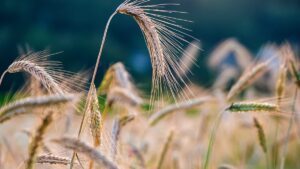
The Ministry of Economy, Environment, and Agriculture forecasts a 6% increase in harvest in 2025 compared to last year due to an increase in grain crops, said Minister of Economy, Environment, and Agriculture Oleksiy Sobolev.
“Overall, this year’s harvest is expected to be slightly higher — about 6% higher than last year. The growth will be primarily due to grain crops — approximately 59 million tons are expected, compared to 56 million tons last year,” he said in an interview with Forbes Ukraine.
The oilseed harvest will remain at last year’s level. We expect a harvest of about 79 million tons of grain and oilseeds combined.
The minister noted that farmers sowed 4.8 million tons of winter crops this year (74% of the forecast) and harvested 37.6 million tons of grain (73% of all sown areas).
He emphasized that in 2025, the harvest in Ukraine will be collected later. This is reflected in the skewed GDP growth in the second half of the year, as part of the money that went into the first half of the year will go into the second half due to weather conditions.